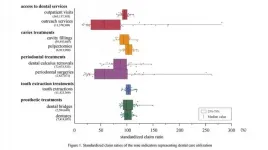Study finds survival is more important than a chronic medical condition in prioritizing medical care
Findings support excluding chronic heart failure, cirrhosis, chronic lung disease from a list of conditions which should be triaged as lower priority for ventilators if there is a shortage
2021-06-14
(Press-News.org) (Boston)-- The concept of rationing medical resources during the height of COVID-19 pandemic created tremendous anxiety in the patient and healthcare communities. In planning for that possibility Massachusetts created a triage scoring system focusing on an acute survival score that considers chronic life-limiting medical conditions of the patient, but it does not provide specifics about how to value those conditions in the equation.
Now a new study supports prioritizing resources to those who are most likely to survive an acute illness as several chronic medical conditions had less of an impact on longer-term survival than previously suspected.
"No one ever wants to use a triage system to ration ventilators, leading some people to die from lack of ability to provide care. However, in the event of such a crisis, like the COVID-19 pandemic, the public needs to be confident that those who are prioritized to receive a ventilator for example, have a higher likelihood of survival," explained corresponding author Anna Cervantes-Arslanian, MD, assistant professor of neurology at Boston University School of Medicine.
The researchers obtained the hospital records of all patients admitted to an Intensive Care Unit at Boston Medical Center (BMC) in the first 15 days of April in 2015 and 2019 and applied the scoring system the hospital developed for prioritizing patients during the first wave of the COVID-19 pandemic. Patients with chronic medical conditions (kidney failure on dialysis, cirrhosis, chronic lung disease, congestive heart failure, dementia, metastatic cancer) were given a score associated with their likelihood of dying in one and five years. They then assessed in 2016 and 2020 whether patients indeed were alive or dead.
What they discovered was that there was a lot of variability amongst "chronic medical conditions" with the criteria for some illnesses being better than others at predicting death. Certain patients with conditions which they thought would be associated with a high mortality at one and five years were actually alive. The researchers also note that a very small number of patients actually met the criteria being used to triage resources, thus providing a strong reason to eliminate or decrease importance of chronic medical conditions in the scoring.
"The public has a right to understand the specifics of how medical resources are utilized/triaged and whether the system to determine utilization is based upon scientific evidence versus assumptions. Our findings support weighing acute survival as much more important than chronic medical conditions because in some cases, we were not good at identifying populations with high mortality," added Cervantes-Arslanian, who is also director of neurocritical care at BMC.
These findings appear online in the journal Critical Care Medicine.
INFORMATION:
ELSE PRESS RELEASES FROM THIS DATE:
2021-06-14
(Boston)--Despite evidence regarding the benefits of vaginal birth after cesarean and recommendations to support shared decision making to reduce cesarean rates, minority women face many impediments that limit their access to appropriate health information and opportunities for such discussions.
Haitian women in Massachusetts have the highest rates of cesarean section and low rates of vaginal birth after cesarean, despite evidence suggesting that many are eligible to attempt vaginal birth after a previous cesarean.
Now a new study explores how Haitian women's beliefs, values and attitudes influence their decision making about pregnancy and birth after having had a cesarean delivery. In conjunction with the providers' views about Haitian women, the information ...
2021-06-14
Farmed foxes selectively bred for tameness and aggressiveness exhibit similar changes to their brain anatomy, according to research recently published in JNeurosci. Both lineages also have larger brains than conventional farm-bred foxes, complicating leading theories on domestication.
Domesticated species provide insight into complex evolutionary processes on a condensed timeframe. When a species splits from its wild counterpart, its brain, body, and behavior undergo rapid changes. Studies with chickens, sheep, cats, dogs, and more indicate domestication shrinks the brain. But the same pattern does not extend to foxes in the expected way.
Hecht et al. used MRI to measure the brain size ...
2021-06-14
When Erin Hecht was earning her Ph.D. in neuroscience more than a decade ago, she watched a nature special on the Russian farm-fox experiment, one of the best-known studies on animal domestication.
The study, running since 1958, tries to replicate the natural domestication of wolves to dogs by selectively breeding two strains of silver foxes so they exhibit certain behaviors. Scientists breed one to be tame and display dog-like behaviors with people, such as licking and tail wagging. The other is bred to react with defensive aggression when faced with human contact, while a third strain acts as the control and isn't bred for any specific behaviors.
Hecht, who's now an assistant professor in the Harvard Department of Human ...
2021-06-14
Niigata, Japan - In the recent past, there has been a paradigm shift towards renewable sources of energy in order to address the concerns pertaining to environmental degradation and dwindling fossil fuels. A variety of alternative green energy sources such as solar, wind, hydrothermal, tidal etc., have been gaining attention to reduce the global carbon footprints. One of the key challenges with these energy generation technologies is that they are intermittent and are not continuously available.
"We cannot use solar energy at night and wind energy when the wind is not blowing. But we can store the generated electricity in some other forms and utilize it whenever required. That is how water splitting bridges the gap and has emerged as a very promising energy storage ...
2021-06-14
Tsukuba, Japan - Inequitable access to health care is a pressing global health concern, and care of our teeth is no exception. In fact, the World Health Organization established the Global Goals for Oral Health 2020 in its efforts to help counter socioeconomic-related imbalances. Economically advanced Japan has plentiful dentists, as well as a universal health insurance system, yet it also has oral care-related inequities, according to a new study.
A team of researchers centered at University of Tsukuba in Japan examined a huge set of claims and checkup data in search of regional and socioeconomic trends. Their findings included the key observation that regional lower ...
2021-06-14
The potential of a class of materials called perovskites to enable solar cells to better absorb sunlight for energy production is widely known. However, this potential has yet to be fully realised, particularly under real-world operating conditions.
New research published today in the prestigious journal Nature Energy, has revealed defects in a popular perovskite light absorber that impede solar cell performance. The researchers found a change in the nature and density of these 'intragrain planar defects' correlated with a change in solar cell performance.
The discovery by an international team of researchers, led by Monash ...
2021-06-14
Cities and nations around the globe are shooting for carbon neutrality, with some experts already talking about the need to ultimately reach carbon negativity. Carbon footprint declarations are used in construction to ease product selection for low carbon building, but these standards don't yet exist for green elements like soil, bushes and plants. A new study led by Aalto University is the first to map out how green infrastructure can be a resource for cities on the path to carbon neutrality.
The study, done in collaboration with the Natural Resources Institute Finland (Luke) and the University of Helsinki, charted out the lifecycle phases of plants, soils and mulches to determine the basic considerations needed to create standards for products commonly used in green ...
2021-06-14
The National Pharmaceutical Regulatory Agency (NPRA) of Malaysia has granted a conditional registration for a safe, effective hepatitis C treatment developed by a public-private partnership bringing together the Malaysian Ministry of Health, not-for-profit research and development organization Drugs for Neglected Diseases initiative (DNDi), Egyptian pharmaceutical company Pharco, Malaysian pharmaceutical company Pharmaniaga Berhad, and non-governmental-organization Médecins Sans Frontières/Doctors Without Borders (MSF).
This is the very first drug for hepatitis C virus (HCV) to be developed through South-South collaboration and with funding and clinical support from non-profit organizations.
This partnership ...
2021-06-14
A current challenge for sustainable aquaculture is how to increase the quantities of farmed fish while also reducing waste products that can lead to the accumulation of harmful fish sludge. New research aims to understand how this fish waste can be treated for use in aquaponics systems, by removing excessive carbon, yet preserving the mineral nutrients required by plants to grow.
In this study in Frontiers in Plant Science, researchers from the Department of Marine Sciences at the University of Gothenburg, Sweden, demonstrate a novel and effective way to convert this fish sludge into plant fertilizer and therefore improving the nutrients available for plants in hydroponic ...
2021-06-14
DNA is an abundant and nutritious food source for microbes
The diet of microbes is vast: They are able to use different molecules as nutrients, including biomolecules such as proteins and lipids of dead and decaying organisms. This includes so called extracellular DNA molecules which are not or no longer present in intact cells. "From the bacteria's perspective DNA is particularly nutritious," says Kenneth Wasmund, a microbiologist at the Centre for Microbiology and Environmental Systems Science (CMESS) at the University of Vienna and lead author of the study. "It's essentially a fertilizer. After all, it is a chain of millions of pieces of sugar and phosphorus- and nitrogen-containing bases." Extracellular ...
LAST 30 PRESS RELEASES:
[Press-News.org] Study finds survival is more important than a chronic medical condition in prioritizing medical care
Findings support excluding chronic heart failure, cirrhosis, chronic lung disease from a list of conditions which should be triaged as lower priority for ventilators if there is a shortage



